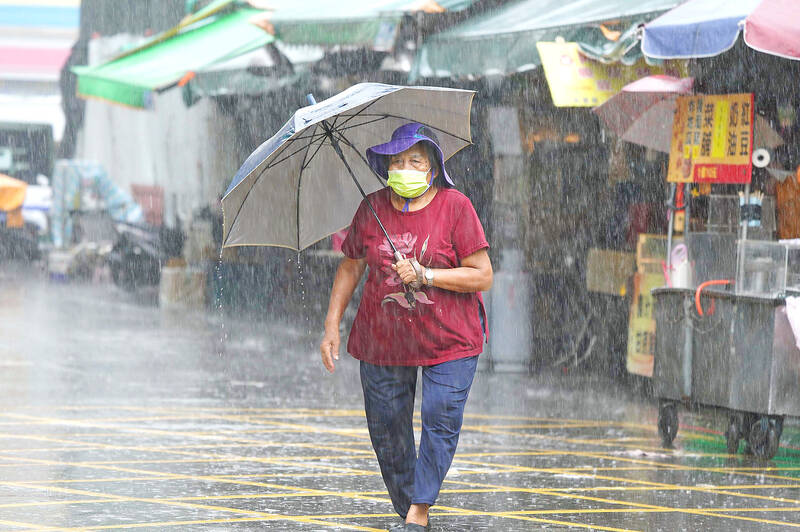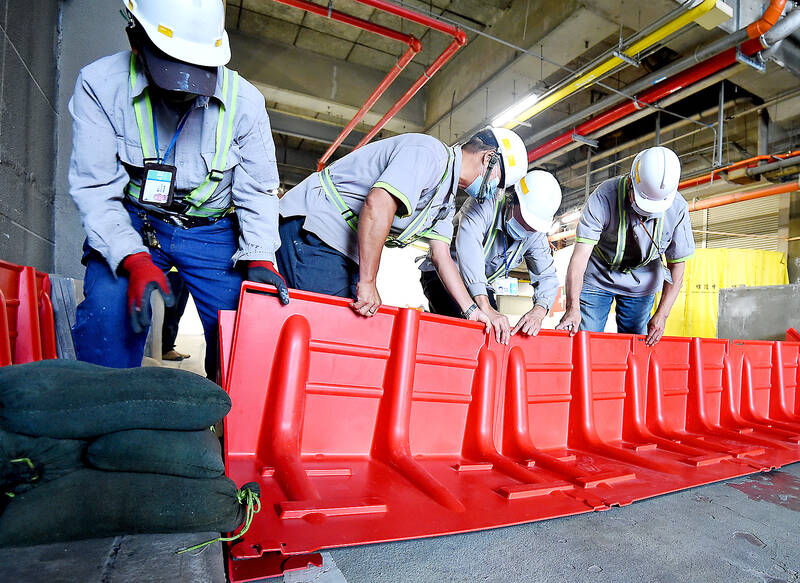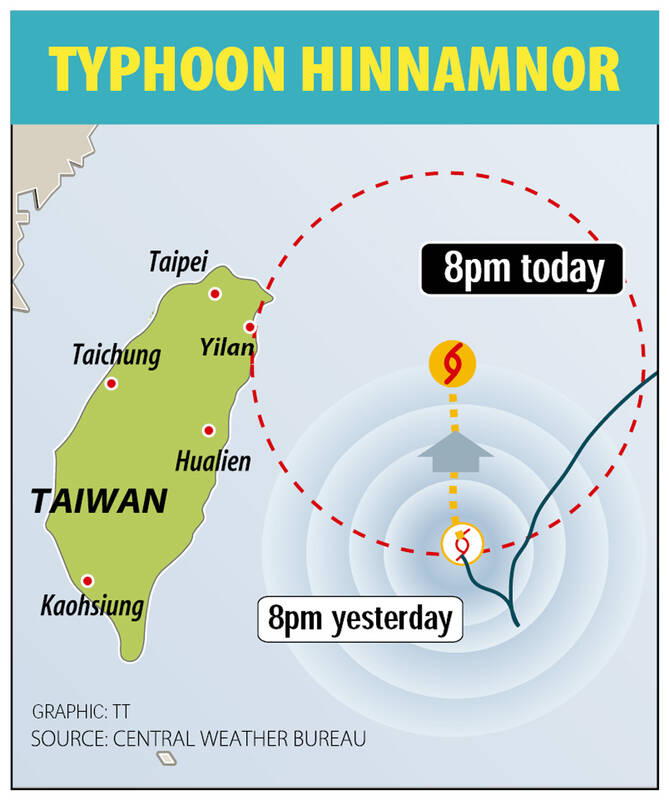A land warning is possible for Typhoon Hinnamnor as early as 2:30am today if the storm remains on its path and continues to expand, the Central Weather Bureau (CWB) said yesterday.
As of 5pm, the typhoon was centered 410km east of Oluanpi (鵝鑾鼻) on Taiwan’s southern tip and was moving north at 15kph, the bureau said.
Hinnamnor had maximum sustained winds of 162kph, with gusts of up to 198kph, it said.

Photo: CNA
CWB forecaster Lin Ping-yu (林秉煜) said the typhoon has weakened slightly, but its radius is likely to expand.
As of 5:50pm, accumulated rainfall totaled 207.5mm on Taipei’s Yangmingshan (陽明山), 177mm in Beitou District (北投) and 174mm on Yilan County’s Taipingshan (太平山).
Local authorities in northern Taiwan reported property damage from wind and rain in several places, but no injuries.

Photo: Chu Pei-hsiung, Taipei Times
School closures were announced for today for New Taipei City’s Pingsi (平溪), Rueifang (瑞芳), Shuangsi (雙溪) and Gongliao (貢寮) districts.
Other districts in New Taipei City, as well as Taipei, Keelung, Hsinchu County, Yilan County and Hualien County announced that criteria were not met for closures.
Taoyuan and Hsinchu City said no closures would be necessary.

In the capital, Taipei Rapid Transit Corp activated its typhoon prevention and response measures for the metropolitan railway system. Under the measures, when wind gusts reach level 10 (about 96kph) or the average wind speed within a 10-minute period reaches level 7 (about 56kph), services along elevated and outdoor lines would be temporarily suspended.
Underground sections would continue to operate, with times adjusted according to crowd conditions, the company said.
To prevent flooding, the MRT operator also put flood gates and water pumps on standby, and was increasing inspections in stations, underground shopping areas, parking lots and train depots, it said.
Flood-prevention facilities throughout the system can handle water levels of up to 110cm, which is based on flood data from the past few years, it said, adding that some stations are equipped with flood gates that activate when water passes through train tunnels near fault zones and river crossings.
However, there was good news for Taiwan’s reservoirs, which had been running low in the absence of any typhoons so far this year.
“Despite concerns, there is a benefit to typhoons for Taiwan, especially at times like now when there is a water shortage,” CWB Director-General Cheng Ming-dean (鄭明典) said.
Seasonal rainfall this summer was 40 percent the average amount measured in the past few years, the second-lowest on record, he said.
Minister of Transportation and Communications Wang Kwo-tsai (王國材) said the water level at Keelung’s Sinshan Reservoir (新山水庫) was at 38 percent capacity just a few days ago, and a yellow alert might have been called today, but rainfall brought by Hinnamnor improved the situation.
The typhoon is expected to bring 400mm to 700mm of rainfall, with most rain forecast in mountainous areas north of Miaoli County.
Meanwhile, the Yushan National Park Administration suspended admission to the park until after the typhoon passes.
Those who had been approved to enter would have to reapply after the closure is lifted, it said.
Such closures are standard procedure during typhoons, as strong winds and torrential rain might cause road closures, landslides and damage to trails that can be dangerous for hikers.
“Throughout the typhoon season — which is generally from June to September — we advise hikers and climbers to establish meeting points with their group, and to ensure they have functioning communications and positioning equipment,” it said.

The Ministry of Foreign Affairs (MOFA) yesterday said it is closely monitoring developments in Venezuela, and would continue to cooperate with democratic allies and work together for regional and global security, stability, and prosperity. The remarks came after the US on Saturday launched a series of airstrikes in Venezuela and kidnapped Venezuelan President Nicolas Maduro, who was later flown to New York along with his wife. The pair face US charges related to drug trafficking and alleged cooperation with gangs designated as terrorist organizations. Maduro has denied the allegations. The ministry said that it is closely monitoring the political and economic situation

UNRELENTING: China attempted cyberattacks on Taiwan’s critical infrastructure 2.63 million times per day last year, up from 1.23 million in 2023, the NSB said China’s cyberarmy has long engaged in cyberattacks against Taiwan’s critical infrastructure, employing diverse and evolving tactics, the National Security Bureau (NSB) said yesterday, adding that cyberattacks on critical energy infrastructure last year increased 10-fold compared with the previous year. The NSB yesterday released a report titled Analysis on China’s Cyber Threats to Taiwan’s Critical Infrastructure in 2025, outlining the number of cyberattacks, major tactics and hacker groups. Taiwan’s national intelligence community identified a large number of cybersecurity incidents last year, the bureau said in a statement. China’s cyberarmy last year launched an average of 2.63 million intrusion attempts per day targeting Taiwan’s critical

‘SLICING METHOD’: In the event of a blockade, the China Coast Guard would intercept Taiwanese ships while its navy would seek to deter foreign intervention China’s military drills around Taiwan this week signaled potential strategies to cut the nation off from energy supplies and foreign military assistance, a US think tank report said. The Chinese People’s Liberation Army (PLA) conducted what it called “Justice Mission 2025” exercises from Monday to Tuesday in five maritime zones and airspace around Taiwan, calling them a warning to “Taiwanese independence” forces. In a report released on Wednesday, the Institute for the Study of War said the exercises effectively simulated blocking shipping routes to major port cities, including Kaohsiung, Keelung and Hualien. Taiwan would be highly vulnerable under such a blockade, because it

Conflict with Taiwan could leave China with “massive economic disruption, catastrophic military losses, significant social unrest, and devastating sanctions,” a US think tank said in a report released on Monday. The German Marshall Fund released a report titled If China Attacks Taiwan: The Consequences for China of “Minor Conflict” and “Major War” Scenarios. The report details the “massive” economic, military, social and international costs to China in the event of a minor conflict or major war with Taiwan, estimating that the Chinese People’s Liberation Army (PLA) could sustain losses of more than half of its active-duty ground forces, including 100,000 troops. Understanding Chinese